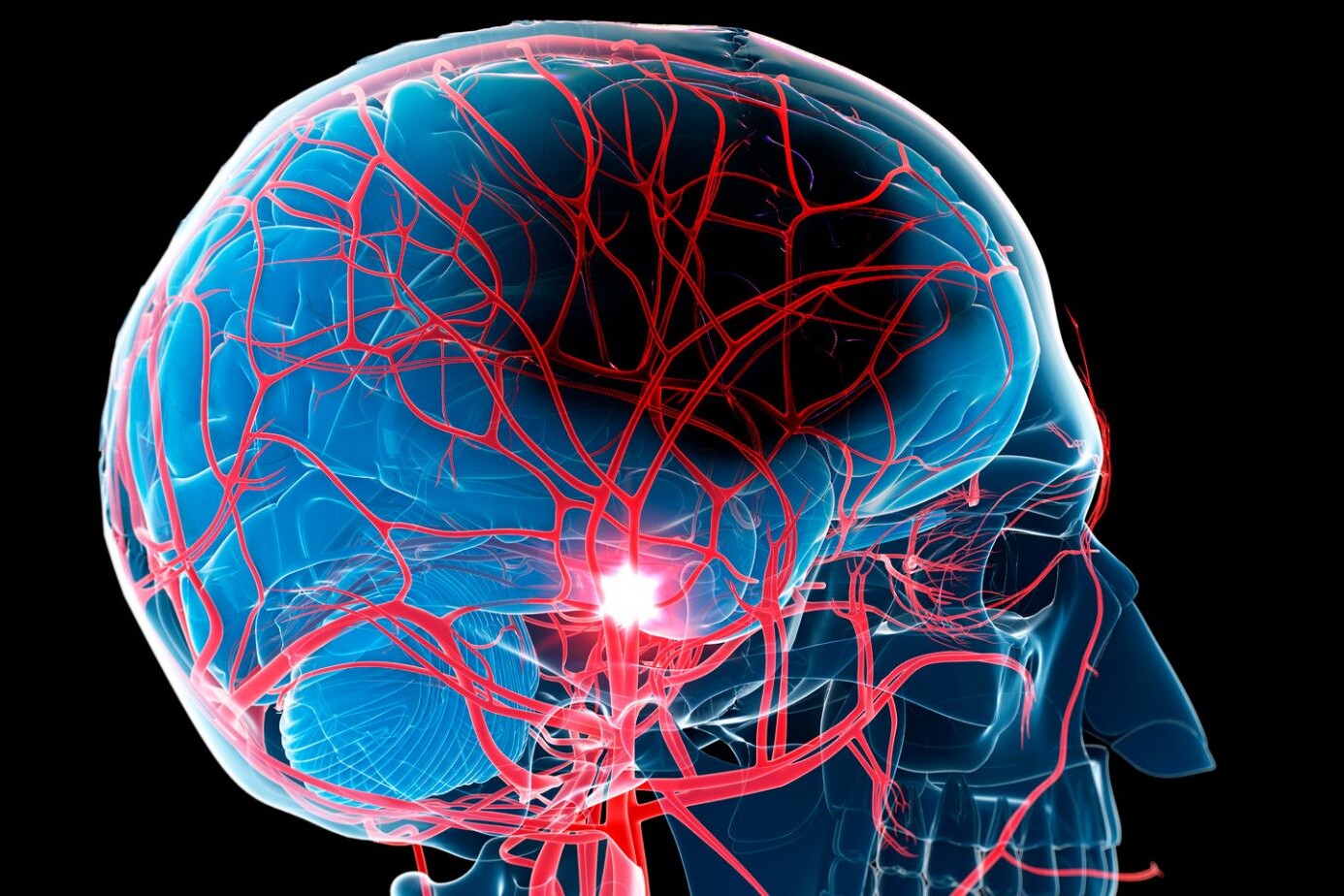Ischemic strokes are a major health issue, making up 85% of all strokes and it happens when a blood clot blocks a vital brain blood vessel. This blocks blood supply to the brain.
Ischemic stroke symptoms can start suddenly. They may include trouble speaking, a hard time understanding others, and feeling numb or unable to move one side of your face, arm, or leg. You might have issues seeing with one or both eyes, walking, or keeping your balance. If these signs come and go, it’s vital to get medical help right away. Fast action is key in ischemic stroke treatment because every minute matters.
Getting help fast can lower the risk of severe brain damage, death, or disability from an ischemic stroke. Knowing the signs and acting promptly can lead to life-saving care. This can significantly improve your health. In dealing with ischemic stroke management, time is of the essence.
Table of Contents
ToggleUnderstanding Ischemic Stroke: A Life-Threatening Emergency
An ischemic stroke happens when a blood clot or plaque piece blocks a brain’s vital blood vessel. It stops the blood flow, leading to an ischemic stroke definition. This kind of stroke is more frequent than hemorrhagic strokes, making up more than 85% of cases. Dr. Chandril Chugh says this affects about 800,000 Americans yearly. And these strokes are a main cause of death and disability. Getting quick treatment is key to reducing brain damage and serious outcomes.
What is an Ischemic Stroke?
An ischemic stroke comes from a clot or plaque block in the brain’s crucial blood vessel. This stops blood flow, which can cause lasting brain damage if not treated fast.
Prevalence and Impact of Ischemic Strokes
Ischemic strokes are the most common, making up about 87% of all strokes in the U.S. Each year, nearly 800,000 individuals suffer from them. So, the prevalence of ischemic stroke is a big health issue. These strokes often lead to death or severe disability in those impacted.

Knowing the signs of an ischemic stroke and seeking urgent care is critical. Time is brain, and acting fast can reduce damage. It also boosts the chances of surviving and recovering.
Ischemic Stroke Symptoms: Act F.A.S.T.
It’s vital to know the signs of an ischemic stroke. Fast medical help could save a life. Look for facial drooping, arm weakness, and speech difficulty.
Face Drooping: A Telltale Sign
One clear sign is a sudden drooping face, often on just one side. It might show as a crooked smile or not being able to shut an eye.
Arm Weakness: Inability to Raise Arms
Suddenly feeling weak or numb in an arm is a sign. Asking them to lift both arms could reveal one arm falling down or not moving.
Speech Difficulty: Slurred or Incomprehensible Speech
Stroke victims may not speak clearly. Their words might be hard to make out. They might struggle to talk or seem lost.
Other signs, like vision problems, walking difficulty, and balance loss, might occur. Act F.A.S.T. and get help at once. Every minute is important in stroke care. Call 911 immediately to improve their chance of recovery.
Risk Factors for Ischemic Stroke
Dr. Chugh says many things can up your chance of a stroke. If you’re 55 or older, male, or of African-American or Hispanic descent, you’re at risk. Family history, being overweight or inactive, and heavy alcohol or drug use also matter. So does smoking, high blood pressure or high cholesterol, and poorly managed diabetes. Certain heart diseases are a risk too. Knowing and handling these risk factors can lower your chance of a stroke.
Age and Gender
Those 55 and older face a higher risk of ischemic stroke. Men are more likely to have a stroke than women. It’s key to be aware of these risk factors. They can help you stay alert about health and get quick medical help if needed.
Race and Ethnicity
Stroke risk can change based on your race and ethnicity. African Americans and Hispanics are more at risk. They also face worse outcomes. This includes a higher death and disability risk. Knowing about these risks is important. It ensures everyone gets the care and treatment they need.
Lifestyle Factors
Your lifestyle choices really matter. Being too heavy or not active, and using a lot of alcohol, drugs, or smoking, increase your stroke risk. A good diet, regular exercise, and dropping bad habits are key. They can lower your risk of a stroke.
Medical Conditions
Health conditions play a big role in stroke risk too. High blood pressure, high cholesterol, and unmanaged diabetes are major risks. So are heart problems like atrial fibrillation. They can make blood clots more likely, which can cause a stroke. It’s critical to handle these conditions. This helps prevent strokes.

Diagnostic Tests for Ischemic Stroke
If you or someone shows signs of an ischemic stroke, doctors will do tests. These tests will show the type of stroke and the best treatment for ischemic stroke plan. Dr. Chandril Chugh tells us they use a CT scan or MRI to see the brain and blood vessels. They also do a carotid ultrasound to check the carotid arteries and blood tests for more details.
CT Scan and MRI
Doctors use CT and MRI scans to look at the brain for an ischemic stroke. A CT scan comes first. It quickly shows brain images to identify the stroke type. An MRI is used for tricky cases or after a TIA.
Carotid Ultrasound
Carotid ultrasound checks the neck arteries for blockages within 48 hours. It helps doctors find the causes of ischemic stroke. Then they decide on treatments like surgery or stents.
Blood Tests
Blood tests give more info about the patient’s health. They help spot issues like clotting disorders or high cholesterol.
The team needs all this data to diagnose well and plan the right treatment fast. Their goal is to improve blood flow to the brain. This lowers the risk of disability or death.
Ischemic Stroke Treatment: Time is Brain
In treating ischemic stroke, remember: time is brain. With every minute, 1.9 million brain cells may die. Quick treatment is key to reduce brain damage and help the patient recover.
Intravenous Clot-Busting Medication
One main treatment is giving clot-busting meds like tPA through a vein. This drug dissolves the blockage and lets blood flow back to the brain. Studies, like the one in the New England Journal of Medicine in 1995, show how tPA can greatly help stroke patients.
Endovascular Procedures
For some, doctors use endovascular procedures. These are less invasive and use a tiny tube to remove the clot. Endovascular therapy has revolutionized the treatment of ischemic stroke and is big life saver.
Ischemic Stroke Symptoms: What to Look For.
It’s vital to know the signs of an ischemic stroke. Quick medical help saves lives. Dr. Chugh says look out for ischemic stroke symptoms like sudden facial drooping, arm weakness, and speech problems. Remember the F.A.S.T. acronym. Vision problems, trouble walking, and balance issues may also happen.
If you see these signs in yourself or others, call 911 right away. Don’t wait, even if the symptoms seem to go away.
Knowing and acting fast on ischemic stroke signs can save a life. By getting quick medical help, you boost the chance of recovery. Let’s make sure people get the care they need, without delay.
Conclusion
Ischemic strokes are serious and need quick treatment. Signs include face drooping, weak arms, and trouble speaking. Call 911 fast to boost your chances of help and recovery.
Reducing risk is important too. This means watching your age, lifestyle, and other health factors. Thanks to new medical advancements, doctors can now help more.
Learn about ischemic stroke overview and ischemic stroke management guidelines. This knowledge can help you and your family stay healthy. Remember, acting fast is key to surviving a stroke.
FAQ
What is an ischemic stroke?
An ischemic stroke happens when a blood clot blocks a brain blood vessel. This stops blood from reaching the brain.
How common are ischemic strokes?
Ischemic strokes are common, making up more than 85% of all strokes. They affect about 800,000 Americans every year.
What are the symptoms of an ischemic stroke?
Key signs of an ischemic stroke are sudden face drooping, arm weakness, and speech problems. Remember, F.A.S.T. stands for Face, Arms, Speech, Time – act quickly if these signs show up. You might also have trouble seeing, walking, or staying balanced.
What are the risk factors for an ischemic stroke?
Stroke risk factors include age (55+), being male, and having certain backgrounds like African-American or Hispanic. Other risks are family history of heart issues, obesity, not being active, heavy drinking or drug use, smoking, and high blood pressure. High cholesterol and diabetes also raise your risk.
What diagnostic tests are used to diagnose an ischemic stroke?
Doctors may do a CT scan or MRI to look at the brain and vessels. A carotid ultrasound checks your neck arteries. Blood tests offer more info on your health condition.
What are the treatment options for an ischemic stroke?
Treatments can include meds to break up the clot, like tPA, which helps get blood flowing again. Doctors might also remove the clot with a thin tube called a catheter. Surgery could be needed in some cases too.
Why is prompt treatment for an ischemic stroke so important?
Quick treatment is key because each minute without blood, 1.9 million brain cells can die. The faster someone gets help, the more brain function they can save.
Source Links
- https://www.mayoclinic.org/diseases-conditions/stroke/symptoms-causes/syc-20350113
- https://www.ssmhealth.com/services/neurosciences/stroke/ischemic-stroke
- https://medlineplus.gov/ischemicstroke.html
- https://my.clevelandclinic.org/health/diseases/24208-ischemic-stroke-clots
- https://my.clevelandclinic.org/health/diseases/5601-stroke
- https://www.webmd.com/stroke/understanding-stroke-symptoms
- https://health.ucdavis.edu/blog/cultivating-health/learn-the-5-stroke-symptoms-and-why-you-need-to-act-fast-to-help/2023/05
- https://www.medicalnewstoday.com/articles/318098
- https://www.hopkinsmedicine.org/health/conditions-and-diseases/stroke
- https://www.mayoclinic.org/diseases-conditions/stroke/diagnosis-treatment/drc-20350119
- https://www.nhs.uk/conditions/stroke/diagnosis/
- https://www.aafp.org/pubs/afp/issues/2015/0415/p528.html
- https://www.ncbi.nlm.nih.gov/pmc/articles/PMC6188407/
- https://www.ncbi.nlm.nih.gov/pmc/articles/PMC6707502/
- https://www.ncbi.nlm.nih.gov/books/NBK499997/
About The Author

This article is medically reviewed by Dr. Chandril Chugh, Board-Certified Neurologist, providing expert insights and reliable health information.
Dr. Chandril Chugh is a U.S.-trained neurologist with over a decade of experience. Known for his compassionate care, he specializes in treating neurological conditions such as migraines, epilepsy, and Parkinson’s disease. Dr. Chugh is highly regarded for his patient-centered approach and dedication to providing personalized care.
→ Book a consultation to discover which remedies suit your needs best.




